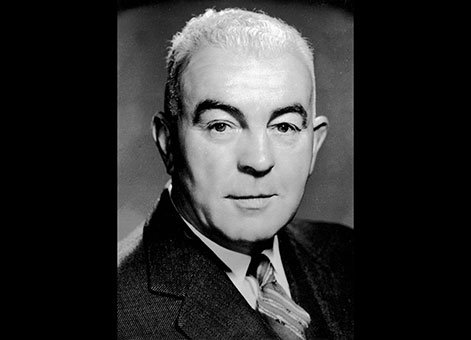Frederick Melrose Horowhenua Hanson, New Zealand’s Commissioner of Works from 1955 to 1961 and President of the New Zealand Institution of Engineers (NZIE, now the Institution of Professional Engineers New Zealand (IPENZ)) 1955–56, died on 15 July 1979.

Frederick Hanson, circa 1956, Past Presidents Album. IPENZ.
Education and early career
An old boy of Wellington College, Hanson interrupted his studies at Victoria University College and the University of Canberra to enlist in the 1st New Zealand Expeditionary Force at the age of 19. He was awarded the Military Medal in World War One.
On his return to New Zealand after two and a half years' service in World War One, Hanson qualified as a surveyor with a private Wellington firm, and in 1921 he joined the Public Works Department. He worked on hydro-electric developments at Mangahao and Waikaremoana and in the Wellington district office until World War Two.

Frederick Hanson, From New Zealand Engineering, March 1956, p81.
World War Two
He again went off to war, with the second echelon as a Major in command of the 7th Field Company. Hanson served with considerable distinction, leading the New Zealand Engineers in Greece, Crete, Africa and Italy, and by 1944 he was New Zealand Division’s commander, Royal Engineers and a brigadier. In Africa much work was done on laying and clearing large minefields, and the technique developed was so successful that it was followed by the rest of the 8th Army. In Italy the Engineers were engaged largely on bridging and roading under campaign conditions, using Bailey bridges and mechanical equipment. Under Brigadier Hanson’s leadership, the work resulted in the Engineers being used right forward in the attack and contributed largely to the successful breakthroughs by the New Zealand Division. This service was recognised with the Distinguished Service Order and bar, and Hanson also became an Officer of the Order of the British Empire (OBE).

Colonel F M H Hanson, Officer in Command NZ Engineers, in Italy, World War II...[circa 29 November 1943]. Ref; DA-04668-F. Alexander Turnbull Library...
A leading engineer
After his return to New Zealand Hanson became the Main Highways Board’s Chief Engineer and Chairman of the National Roads Board. In 1951 he was appointed Deputy Commissioner of Works, becoming Commissioner of Works on the retirement of Edgar Ravenswood McKillop in 1955. Hanson retired on 21 December 1961, becoming a Companion of the Order of St Michael and St George (CMG) in the same year.
In 1951 he was offered the position of Assistant Secretary-General in the Middle East for the United Nations, but declined. In 1952 he was appointed an associate member of the Army Board, becoming the first Territorial officer to join. In 1959 he was a member of the New Zealand Council for Technical Education.
In a tribute to Hanson, David Alan Thom (NZIE President 1979–80) said the country would remember Hanson as a top construction engineer, public servant, and soldier, but his contributions to international practice in design methods for roading should not go unrecorded. Hanson's publication in 1935 of the results of his testing and field observations established the fundamental design principles of the chip seal road surface that’s still in use today. Known worldwide, Hanson's design method has provided the basis for nearly all design methods for chip seals currently used.
Thom noted Hanson's combined abilities of clear thinking, simplification and then getting on with the job that led to his effectiveness as a soldier and professional engineer "have also guaranteed him a permanent memorial in worldwide roading practice". Hanson received two special awards for papers on roading given at NZIE conferences in 1937 and 1948.
Find out more
Source
New Zealand Engineering, September 1979, p.220
Further reading
JAB Crawford, “Hanson, Frederick Melrose Horowhenua,” from the Dictionary of New Zealand Biography in Te Ara – the Encyclopedia of New Zealand, last modified 8 October 2013.
